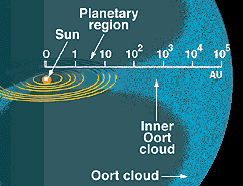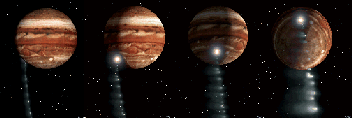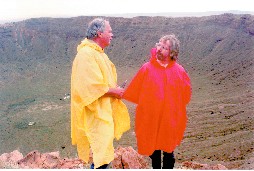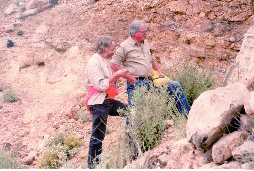Comet Showers
At any given time, stars in the solar neighborhood have typical distances to each other of a parsec or so (a few light years). But since all stars move in random directions, occasionally a star will pass (much) closer to another star. When a star makes a passage close to the sun, it still stays far outside the planetary system.  But such a passage may perturb the comets in the Oort Cloud, spread out over an area more a thousand times larger in diameter than the planetary system. While a close passage typically lasts only ten thousand years or so, it may trigger an increase in the frequency of arrival of comets in the inner solar system, which can last for a few million years until equilibrium in the comet cloud is restored again.
But such a passage may perturb the comets in the Oort Cloud, spread out over an area more a thousand times larger in diameter than the planetary system. While a close passage typically lasts only ten thousand years or so, it may trigger an increase in the frequency of arrival of comets in the inner solar system, which can last for a few million years until equilibrium in the comet cloud is restored again.
During such comet showers the probability of impacts of comets on Earth is enhanced; depending on the type of perturbation by a passing star it can even be greatly enhanced. I got interested in this topic when we wrote our first paper on the possibility of a solar companion star, Nemesis, in which we coined the term in the title: Extinctions of Species by Periodic Comet Showers by Davis, M., Hut, P. & Muller, R.A., 1984, Nature 308, 715-717.
While our initial interest was in the consequences of the possible presence of a solar companion star, we realized that the dynamics of comet delivery to the inner solar system would be very similar for the passage of a random, unbound star. The implication was that the frequency of appearance of comets coming freshly from the Oort Cloud was bound to be modulated on time scales of hundreds of thousands and millions of years - short with respect to geological time scales. Consequently, there may not be any meaningful `typical' frequency of arrival of new comets. Just like as is the case with the weather, we may find different behaviors whenever we average over different time scales. This made the term comet showers even more apt.
Mass Extinctions: Sudden or Gradual?
 As an application of the notion of a comet shower, we discussed the conflicting evidence relating to the K/T mass extinction, 65 million years ago, when the dinosaurs died out. At that time, the discovery of an iridium layer, sharply located in time, suggested that there had been a single sudden impact that had disturbed the ecosphere to such an extent that a large fraction of the diversity of life on Earth was wiped out, probably within years, a blink of the eye in paleontological terms. However, other lines of evidence seemed to point to a more gradual dying out of various species.
As an application of the notion of a comet shower, we discussed the conflicting evidence relating to the K/T mass extinction, 65 million years ago, when the dinosaurs died out. At that time, the discovery of an iridium layer, sharply located in time, suggested that there had been a single sudden impact that had disturbed the ecosphere to such an extent that a large fraction of the diversity of life on Earth was wiped out, probably within years, a blink of the eye in paleontological terms. However, other lines of evidence seemed to point to a more gradual dying out of various species.
A lively discussion unfolded between proponents of sudden vs. gradual mass extinctions, with the K/T mass extinction playing a central role, given that so much evidence had already been gathered around it. Perhaps not surprisingly, most (astro)physicists and nuclear chemists taking part in the debate favored a sudden explanation, based on the available hard evidence from the physical sciences, while most geologists and especially paleontologists favored a gradual extinction, based on the fossil record. While the physicists argued that incompleteness of the latter would make it a less accurate witness of the events than the iridium layer, paleontologists were not so sure.
In the middle of this debate, Rich Muller proposed a way to reconcile the positions from both sides of the argument (Muller, R.A., 1985, in The Search for Extraterrestrial Life: Recent Developments, ed. Papagiannis, S., 233 [Reidel]). By postulating a single indirect cause for the mass extinctions, in the form of a passing star triggering a comet shower, he could accomodate a multiplicity of impacts. One of those would have to be the largest and hence most dramatic, while the others could have contributed to a lesser extent in the mass extinction which would then have been spread out over a bit more than a million years. Each impact would contribute another step in the overall extinction events.
In order to give an informed discussion of all aspects of the problem, I gathered a group of eight authors: two astrophysicists, two geologists, and four paleontologists, each with a different area of expertise. It was one of the most interesting, and at the same time one of the most complicated editing jobs I have ever done, given the vast difference in language and attitudes and notions of what consists of solid proof between the various disciplines. The result was a review paper in Nature: Comet Showers as Possible Causes of Stepwise Mass Extinctions, by Hut, P., Alvarez, W., Elder, W.P., Hansen, T., Kauffman, E.G., Keller, G., Shoemaker, E.M. & Weissman, P.R., 1987, Nature 329, 118-126.
Multiple Impacts
A few years later, evidence was offered for stepwise processes around the Eocene-Oligocene boundary, during which a minor mass extinctions occurred, some 35 million years ago. Multiple iridium layers as well as multiple layers of small glassy particles produced in impacts were suggestive of signs of a possible comet shower around that time. In addition, some crater ages had been measured with greater accuracy, and evidence pointed to simultaneous formation of some of those craters.
In response to these intriguing clues, we made a list of possible mechanisms for producing multiple impacts on Earth:
For details, see our paper Astronomical Mechanisms and Geologic Evidence for Multiple Impacts on Earth, by Hut, P., Shoemaker, E.M., Alvarez, W. & Montanari, A., 1991, Lun. Planet. Sci. Conf. Abstr. XXII, 603-604.
 Remarkably, a variant on our scenario B.2.c.i was discovered in real time only three years after we published this paper. For this scenario we had written: ``if tidal breakup of a comet occurs during close passage by the Earth, cometary debris on closely related orbits will spread out into a stream of fragments.'' Replacing the Earth by Jupiter, this is exactly what happened with the comet Shoemaker-Levy when it fragmented during a close passage with Jupiter, leading to spectacular multiple impacts. This was one of the highlights of Gene Shoemaker's career. It was wonderful having him first as co-author on our paper, and then to see a comet bearing the name of him and his wife following one of our impact scenarios. Below are a few photographs of Gene teaching me the geology of the meteor crater in Arizona, in 1992.
Remarkably, a variant on our scenario B.2.c.i was discovered in real time only three years after we published this paper. For this scenario we had written: ``if tidal breakup of a comet occurs during close passage by the Earth, cometary debris on closely related orbits will spread out into a stream of fragments.'' Replacing the Earth by Jupiter, this is exactly what happened with the comet Shoemaker-Levy when it fragmented during a close passage with Jupiter, leading to spectacular multiple impacts. This was one of the highlights of Gene Shoemaker's career. It was wonderful having him first as co-author on our paper, and then to see a comet bearing the name of him and his wife following one of our impact scenarios. Below are a few photographs of Gene teaching me the geology of the meteor crater in Arizona, in 1992.
 |
 |
 |
Kuiper Belt
On a related topic, I collaborated on a study to investigate the formation of binary objects in the Kuiper Belt, the region beyond Neptune's orbit from which comets are thought to originate. We present a scenario that can naturally account for the various differences that distinguish Kuiper Belt binaries from main-belt asteroid binaries. For details, see our paper
- The Formation of Kuiper-belt Binaries through Exchange Reactions, by Funato, Y., Makino, J., Hut, P., Kokubo, E. & Kinoshita, D.; 2004, Nature 427, 518-520 (available in preprint form as astro-ph/0402328).
and also a related conference contribution:
- Three-Body Affairs in the Outer Solar System , by Funato, Y., Makino, J., Hut, P., Kokubo, E. & Kinoshita, D.; 2005, Proceedings of the 35th Symposium on Celestial Mechanics, eds. E. Kokubo, H. Arakida, and T. Yamamoto (Tokyo, Japan; available in preprint form as astro-ph/0512075).